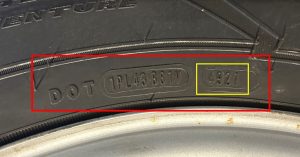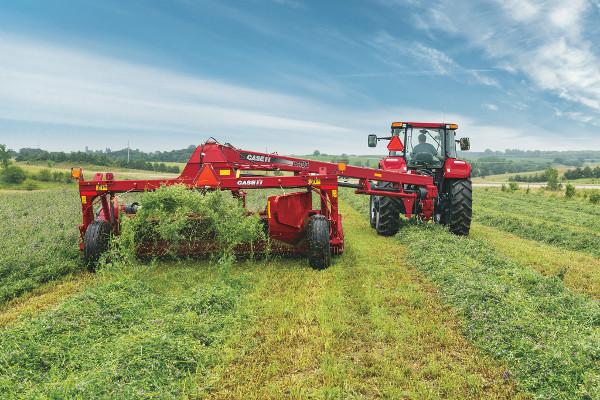
(Source: Penn State University Ag Safety & Health)
Use the following format to cite this article:
PTO-driven post-hole auger safety. (2014) Farm and Ranch eXtension in Safety and Health (FReSH) Community of Practice. Retrieved from http://articles.extension.org/pages/70348/pto-driven-post-hole-auger-safety.
Post-hole augers driven by power take-offs (PTO) are mounted on a tractor and powered by the tractor’s PTO shaft. The transition from manual to mechanical power has reduced manual labor associated with post-hole digging but has increased the risk of injury when an operator does not follow safe operating procedures.
Prior to using any piece of equipment, read the operator’s manual. Follow all recommendations for operation, maintenance, and safety in the manual and on safety signage located on the auger. If you are unable to locate your operator’s manual, check with your local dealership or manufacturer for a replacement copy. Outlined below are safety recommendations to reduce your risk of an incident.
One-Person Operation
A post-hole auger is designed to be operated by one person. When the post-hole digger is in operation, the operator should be seated in the tractor seat. Other than the operator in the tractor seat, no one should be within 20 feet of the post-hole auger during operation. The tractor’s hydraulics should be used to position the auger for starting the hole and should never be manually set. Post-hole augers are equipped with a bar that rotates 90 degrees to enable the operator to remain in the tractor seat while positioning the auger. In the past, some post-hole auger owners would weld a bar to the rear of the machine for a second person to use to add downward pressure, however, this is an unsafe practice with a high risk for an entanglement incident, and this method should never be used.
Personal Protective Equipment
The recommended personal protective equipment (PPE) when operating a post-hole auger includes close-fitting clothing, gloves, eye protection, hearing protection, and appropriate footwear, such as steel-toed boots. In regards to other clothing and hygiene, jewelry, scarves, or clothing with drawstrings should never be worn when operating a post-hole auger. Long hair should be kept securely tied above the shoulders.
Preoperation and Operation
Shields and guards must be in their proper place prior to operating a post-hole auger. New manufacturing standards include guards or shields for auger adapters, PTO drivelines, PTO universal joints, and connections. Depending on the make and model, check with the manufacturer to determine whether older post-hole augers can be retrofitted with updated shielding. Additional operation guidelines include the following:
- Know the area and type of soil where you plan to dig.
- Check the operator’s manual to determine the correct weight to place on the front of your tractor to balance the rear weight of the post-hole auger.
- Remember to set the tractor’s brakes or put the tractor in park before you begin to dig.
- Operate the auger at slow speed to achieve better performance and maintain more control.
- Dig down several inches, and then lift the auger to release the soil. Repeat until the hole is the desired depth.
- When the post-hole auger is not in use, make sure that the PTO on the tractor is shut off and that the auger is lowered to the ground.
- When transporting a post-hole auger, fully raise the auger and watch for obstacles and obstructions that could hit the auger.
Freeing an Auger
If the auger becomes stuck (for example, due to contact with clay, rocks, or tree roots), promptly disengage the PTO and turn off the engine. With the power source is turned off, use a large wrench to slowly turn the auger backwards. After using the wrench, return to the tractor seat and raise the auger hydraulically.
Shear Pins
A shear pin is designed to break when too much pressure is placed on the drive, protecting the post-hole auger. Always use the recommended size and strength shear pin—substitutions may damage the machine and increase your risk of an entanglement incident. Keep a spare shear pin on hand to avoid downtime. Be sure to wear eye protection and gloves when removing a damaged shear pin.
Rocks and Other Obstructions
Post-hole augers have limitations. If a rock or other obstruction is preventing the auger from penetrating the ground, another location may need to be selected. If the selected location must be used, additional digging tools, such as a jackhammer or digging bar, might be needed to complete the hole.
Hydraulics
Hydraulic fluid is stored at very high pressure and can penetrate a person’s skin or eye, causing serious injury or possibly death. Inspect your hydraulic lines for signs of wear and pinhole leaks without touching the lines with your hand. While wearing safety glasses, use a piece of cardboard or wood to pass over the suspected area. If a leak is located, relieve the pressure in the hydraulic system before repairing the leak.
Use the following format to cite this article:
PTO-driven post-hole auger safety. (2014) Farm and Ranch eXtension in Safety and Health (FReSH) Community of Practice. Retrieved from http://articles.extension.org/pages/70348/pto-driven-post-hole-auger-safety.
Sources
Implement for compact tractors: Selection, use, maintenance, and safety (2005) Louisiana State University AgCenter Reserach and Extension. Retrieved from http://www.lsuagcenter.com/nr/rdonlyres/1b522d98-ae78-4dfa-a258-7f845263….
Important safety message for owners/operators of post hole diggers. (n.d.) Farm Equipment Manufacturers Association. Retrieved from http://www.farmequip.org/media/file/PHDAD10.pdf.
Safety management for landscapers, grounds-care business and golf course. (2001) John Deere Publishing. Moline, IL.
Reviewed and Summarized by:
Linda M. Fetzer, Pennsylvania State University – lmf8@psu.edu
Dennis J. Murphy, Pennsylvania State University (Has since retired)





